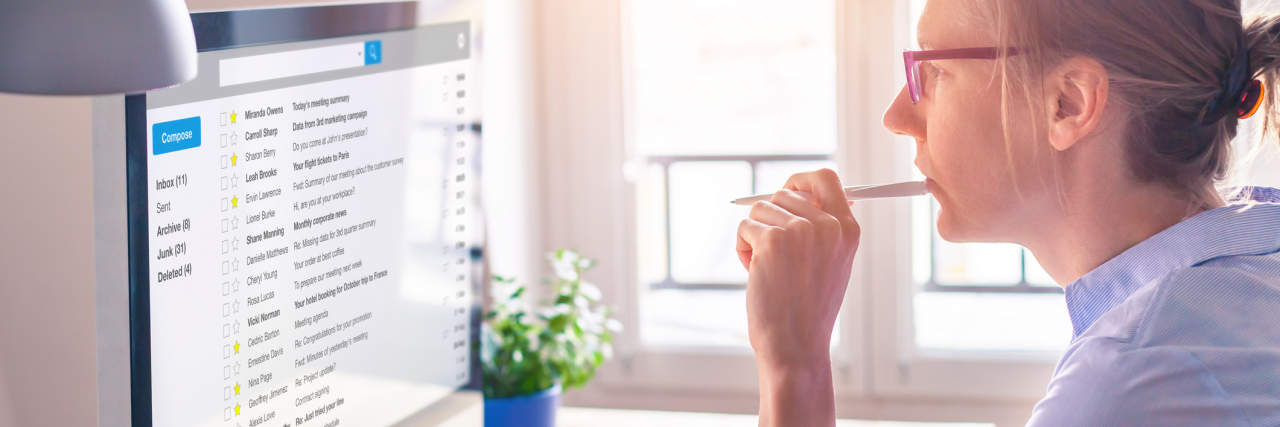9 Tips for Writing Emails When You Live With Anxiety
I don’t know who invented email, but I’d love to give them a piece of my mind. I swear, sending and receiving electronic messages is even more anxiety-provoking than face-to-face communication, which is already stressful enough for me despite being an extrovert. If I could go back to mailing letters, I totally would.
Unfortunately, email communication is a necessary evil for most of us, and living with an anxiety disorder can complicate messaging others even further. However, I have come up with some “hacks” or “tips” to help make writing emails at least slightly anxiety-provoking.
1. Breathe!
I know, I know — telling someone with anxiety to “just breathe” is anything but helpful. However, it is important for anyone experiencing anxiety to take a moment to acknowledge the emotion and, if needed, use coping skills to reduce the intensity of your feelings.
2 Identify the underlying cause of your anxiety.
Obviously sending emails causes an uptick in your anxiety symptoms… but why? Are you worried about how the other person will respond? Are you worried you won’t sound intelligent enough? Does the mere idea of being assertive make your skin crawl?
Identifying the “why” behind your feelings can help you use the right tools and coping skills as you send the message. You may find that sending any type of message triggers your anxiety, or you may find the underlying cause varies based on the situation. Either way, it’s OK.
3. Think about your goal.
Identifying the rationale behind your anxiety can help you decide how to cope. However, identifying the goal of the email you’re working on can help you determine the best approach for tackling the task at hand. It will also help you reframe what’s important and what isn’t worth worrying over.
For example, if you’re emailing out a virtual invitation to your child’s birthday party, then your goal is just to get the information out there in a way that’s easy to read and understand. Inversely, if you’re mailing your resume to a hiring manager, you want to make sure you put your best foot forward.
4. Keep it brief.
When I feel anxious, I tend to ramble, overapologize, and fill awkward pauses with my own voice. Unfortunately, I’ve noticed these same issues translate over into my anxious email messages, too.
Here’s the thing, though: The less time I spend writing a message, the less anxious I feel.
Also, brief messages don’t have to be cold or emotionless. They just get straight to the point, which often removes ambiguity. This can help you avoid misunderstandings or conflicts down the line, which avoids additional anxiety triggers.
5. Don’t reinvent the wheel.
Are you still unsure how to even start your message? Well, chances are if you Google the type of email you’re trying to send, you’ll find at least a few templates or suggestions online. These templates can serve as a guide so you feel more confident in your message.
6. Save it and read it again later.
Sometimes a set of fresh eyes and a different mindset can help when sending particularly important emails out. So, if you have time, consider saving the message as a draft and returning to it once you feel less emotionally invested in it.
If you don’t have time to let the email sit in your Drafts folder for a few hours, you still may want to at least read the message over one more time before sending it. This will help you catch any typos or rambling that may have occurred due to your elevated stress levels.
7. Have someone else look it over.
There are times when a fresh set of eyes can literally mean bringing a new person in to read what you wrote. Depending on the situation, this could be a friend, coworker, family member, or another person you know.
When you ask someone to read it over, it may help if you give them specific guidelines for what you’d like them to look for or correct. You can also tell them if there’s anything you absolutely will not change, as this avoids possible conflict later on.
8. Use a checklist to look over everything at the end.
Checklists can be a great tool for people with anxiety. They help you make sure you don’t forget things, and it gives you reassurance after the fact that you did everything right.
You could easily make an email checklist that includes:
- Verifying the correct recipients are included.
- The subject line is clear.
- Any attachments are included.
- The body of the email is easy to read and (mostly) typo-free.
- Checking your signature line..
When the email is done, set a time limit to use the checklist and get to it. Then you can tell yourself you did everything you needed and push send.
9. Walk away after you send it (or close your inbox).
Unfortunately, the anxiety doesn’t always end once you push “send,” especially if you sit and refresh your inbox every minute or two until you get a reply. For this reason, I make it a habit to either close my inbox or walk away from my desk completely once I send the message. This helps avoid ruminating and gives me a chance to refocus my attention, which lowers my anxiety in a natural way.
Will these suggestions make your anxiety melt away completely? No, probably not. But I do hope they help you feel at least a little less worked up next time you go to type an electronic message to a friend, colleague, or family member.
Getty Images photo via NicoElNino

